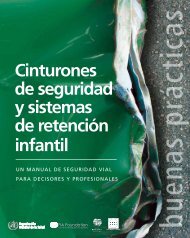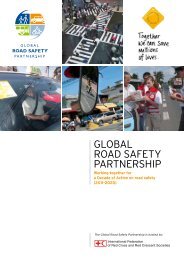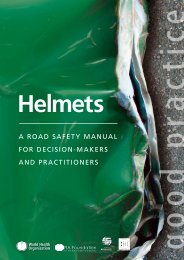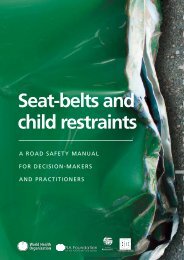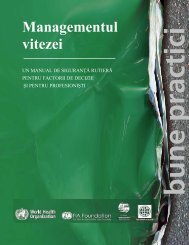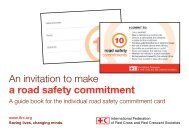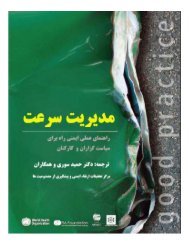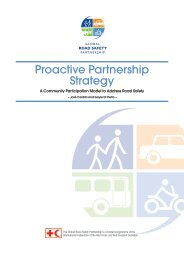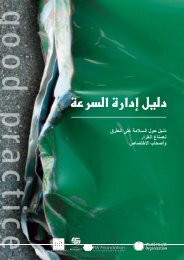How to design and implement a drinking and driving programme pdf ...
How to design and implement a drinking and driving programme pdf ...
How to design and implement a drinking and driving programme pdf ...
You also want an ePaper? Increase the reach of your titles
YUMPU automatically turns print PDFs into web optimized ePapers that Google loves.
Module 3: <strong>How</strong> <strong>to</strong> <strong>design</strong> <strong>and</strong> <strong>implement</strong> a <strong>drinking</strong> <strong>and</strong> <strong>driving</strong> <strong>programme</strong><br />
Pedestrian fencing<br />
Pedestrian fencing may be useful for improving the safety of alcohol-impaired pedestrians,<br />
as it requires no decision-making by the pedestrian. It may be particularly<br />
appropriate at locations where such pedestrians are likely <strong>to</strong> spill out on<strong>to</strong> the road or<br />
cross the road at an inappropriate point, for example, outside licensed premises.<br />
Refuge isl<strong>and</strong>s <strong>and</strong> medians<br />
Refuge isl<strong>and</strong>s <strong>and</strong> medians can assist alcohol-impaired pedestrians in crossing the<br />
road by allowing a staged crossing <strong>and</strong> simplifying the decision-making task. Kerb<br />
extensions can also improve the safety of alcohol-impaired pedestrians by reducing<br />
the crossing distance <strong>and</strong> the area in which the pedestrian is at risk. While such treatments<br />
usually attract pedestrians <strong>to</strong> cross where they are located, alcohol-impaired<br />
pedestrians are probably less likely <strong>to</strong> de<strong>to</strong>ur from their desired line of walking <strong>to</strong><br />
use the facilities. The effectiveness of refuge isl<strong>and</strong>s <strong>and</strong> kerb extensions for alcohol-impaired<br />
pedestrians may therefore depend on their being located where such<br />
pedestrians would be likely <strong>to</strong> cross anyway.<br />
Lighting<br />
Since most crashes involving alcohol-impaired pedestrians occur at night, improved<br />
street lighting is likely <strong>to</strong> have a major impact on this type of event. Improved<br />
lighting has obvious implications for the safety of alcohol-impaired pedestrians by<br />
increasing their visibility <strong>to</strong> mo<strong>to</strong>rists. It also has less obvious implications in terms of<br />
attracting in<strong>to</strong>xicated pedestrians <strong>to</strong> <strong>design</strong>ated crossing places, <strong>and</strong> lessening the risk<br />
of trips or falls. Although relatively costly, lighting can, in some circumstances, be<br />
paid for by the private sec<strong>to</strong>r <strong>and</strong> brings with it a number of social benefits.<br />
Street lighting project, Whiteriver, Arizona, United States<br />
One street lighting project aimed <strong>to</strong> reduce pedestrian injuries – especially<br />
alcohol-related ones – in a Native American jurisdiction in Arizona (23). In the five<br />
years prior <strong>to</strong> the additional street lighting, 15 pedestrian crashes had occurred<br />
along the 1.8 km target section of highway. In the five years after their installation<br />
only three crashes occurred.<br />
Cost-benefit analysis revealed that the installation of the 28 street lights along<br />
the length of highway was followed by an average reduction of 2.5 pedestrian<br />
crashes per year, <strong>and</strong> a benefit-cost ratio of 10.<br />
112



